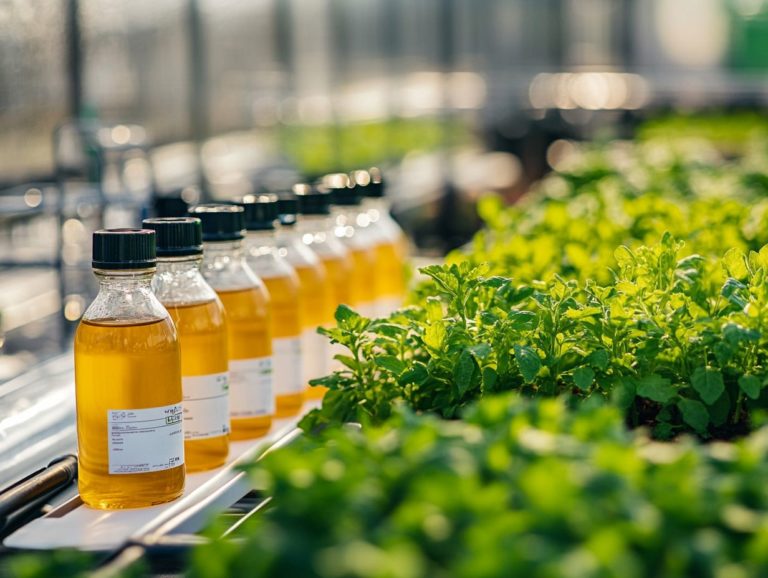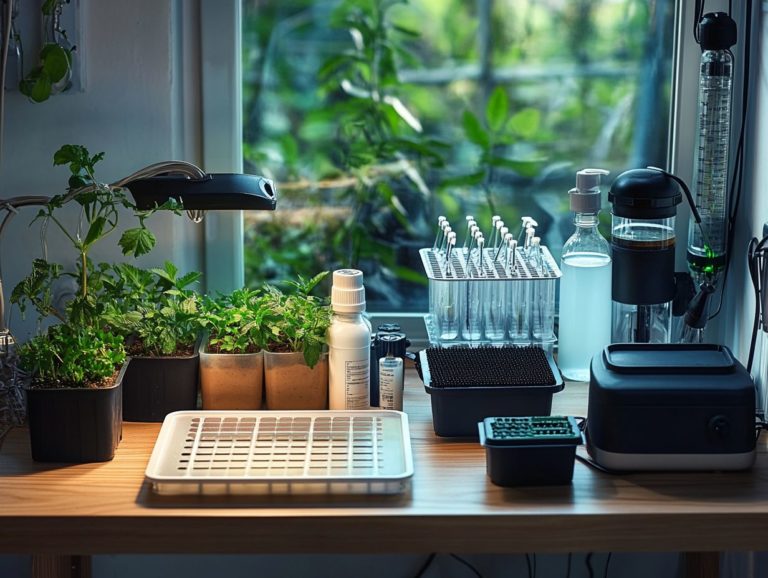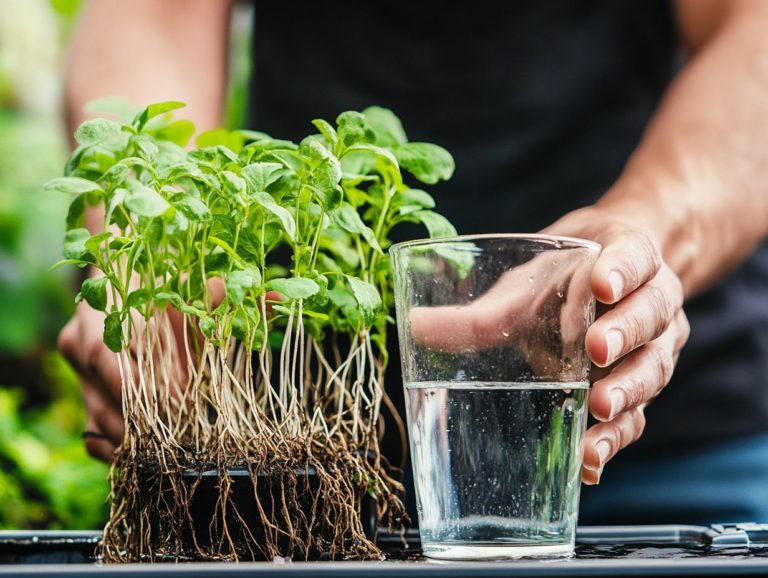What is Passive Hydroponic Gardening?
Passive hydroponic gardening presents a straightforward and efficient approach to cultivating plants, free from the complexities of traditional soil gardening. This method utilizes a self-contained system that nourishes plants effectively, making it perfect for both newcomers and experienced gardeners.
Explore the myriad benefits of passive hydroponic gardening. Learn how to establish your own garden, identify the best plants to grow, and discover essential tips for troubleshooting and maintenance. Get ready to unleash your inner gardener!
Contents
- Key Takeaways:
- Benefits of Passive Hydroponic Gardening
- How to Set Up a Passive Hydroponic Garden
- Plants That Thrive in Passive Hydroponic Systems
- Troubleshooting Common Issues
- Maintaining and Harvesting from a Passive Hydroponic Garden
- Frequently Asked Questions
- What is Passive Hydroponic Gardening?
- How does Passive Hydroponic Gardening work?
- What are the benefits of using Passive Hydroponic Gardening?
- Can I use any type of plant with Passive Hydroponic Gardening?
- Do I need any special equipment for Passive Hydroponic Gardening?
- Is Passive Hydroponic Gardening better than traditional gardening methods?
Key Takeaways:
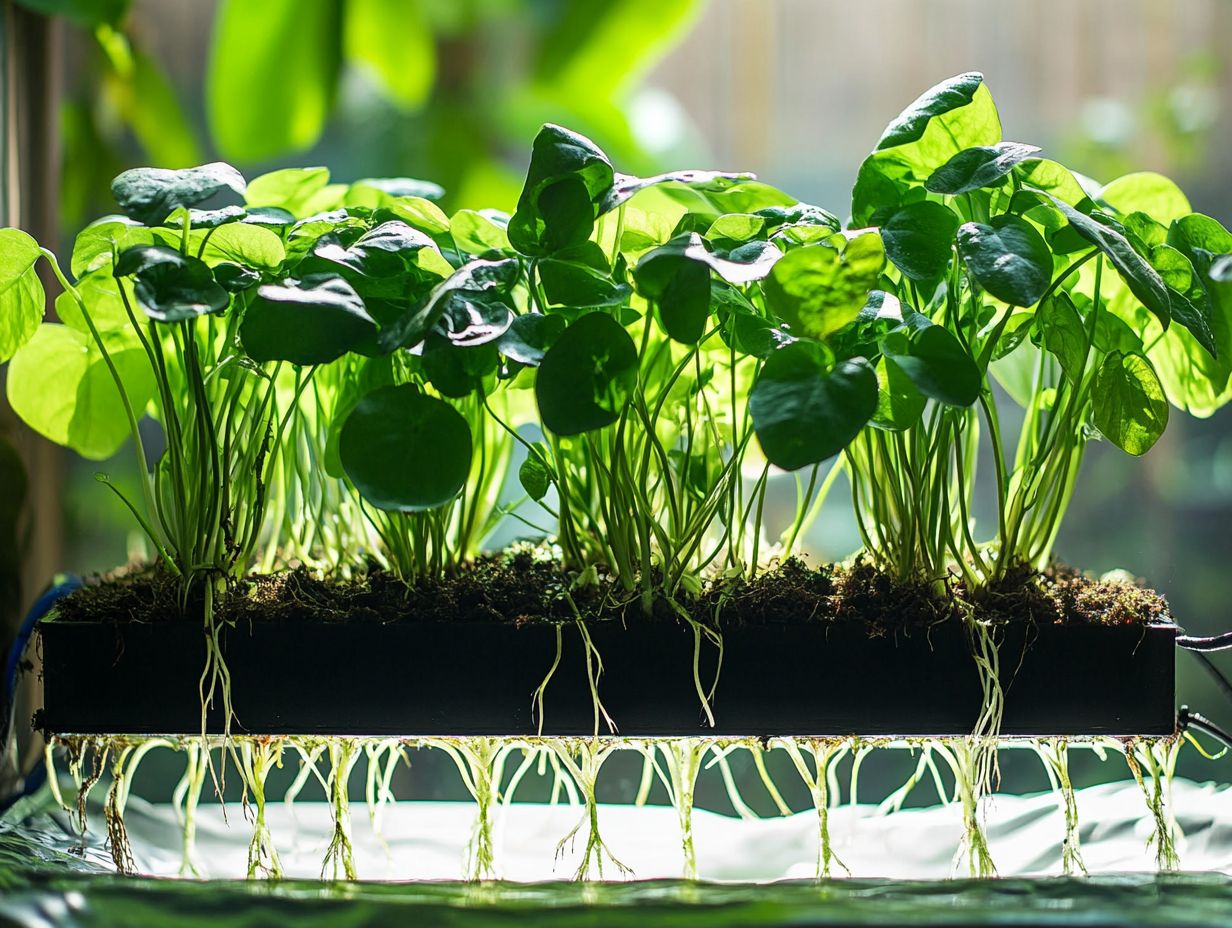
- Passive hydroponic gardening lets you grow plants without soil. It uses a water and nutrient mix to support growth.
- This method boosts yields, speeds up growth, and uses less water compared to traditional gardening.
- To set up a passive hydroponic garden, you will need basic materials and equipment. Follow a step-by-step guide to get started. The best plants to grow in this system include leafy greens, herbs, and certain vegetables.
What is Passive Hydroponic Gardening?
Passive hydroponic gardening, particularly the Kratky Method developed by B.A. Kratky at the University of Hawaii, offers you a groundbreaking way to grow plants without the hassle of traditional gardening methods. With this approach, you can cultivate healthy plants using a simplified setup that employs a nutrient solution (a mix of water and essential plant nutrients) all without the need for continuous water circulation or pumps.
The Kratky Method is a low-maintenance way to grow plants, particularly leafy greens like lettuce and spinach. This makes it perfect for both beginners and seasoned gardeners alike.
What truly differentiates passive hydroponics is its dependence on a static nutrient solution. This means you can spend less time managing nutrients and more time enjoying the thrill of growth. Unlike active hydroponic systems that require pumps and timers to function, this method thrives on simplicity.
By selecting an appropriate growing medium like expanded clay pellets or rock wool you can ensure both stability and aeration for the roots.
Keeping an eye on proper pH levels is essential, as it guarantees that nutrients remain accessible to your plants. This straightforward technique can yield a range of crops, from aromatic herbs to small fruiting varieties like strawberries, all of which greatly benefit from this uncomplicated method.
Benefits of Passive Hydroponic Gardening
The benefits of passive hydroponic gardening are truly remarkable. It offers you a sophisticated approach to efficient plant growth and nutrient management while significantly reducing resource consumption and labor intensity. You will love how easy it is to manage!
With its capacity to yield vibrant, healthy leafy greens, the Kratky Method reshapes your understanding of plant cultivation, making it an enticing option for urban dwellers and gardening enthusiasts alike.
Advantages Over Traditional Gardening
One significant advantage of passive hydroponic gardening over traditional methods is its streamlined approach, which reduces the need for extensive labor and resources. This allows you to make more efficient use of space and nutrients. Unlike soil-based gardening, where you must constantly monitor soil quality and moisture levels, passive hydroponics relies on a carefully balanced nutrient solution that supports healthy plant growth with minimal intervention.
This method not only saves you time but also decreases the likelihood of issues like root rot. It’s perfect for your busy lifestyle while still allowing you to grow your own food.
Passive hydroponic systems use less water than conventional gardening methods, making them especially appealing if you live in regions facing water shortages. The available vertical design options enhance space efficiency and can be particularly beneficial when exploring what is vertical hydroponic gardening, enabling you to cultivate a variety of plants in smaller areas, such as apartments or urban backyards.
With lower maintenance needs, this gardening style invites you to engage with sustainable practices. It promotes both environmental responsibility and personal satisfaction from growing fresh produce all while enjoying a simplified gardening experience that minimizes stress and maximizes joy.
Environmental Benefits
The environmental benefits of passive hydroponic gardening are impressive, especially when it comes to water conservation and minimizing chemical runoff. This method stands out as an eco-friendly choice for sustainable agriculture. By using a nutrient solution that recirculates without the need for pumps, you significantly reduce water waste while ensuring your plants receive the essential nutrients for optimal growth.
This approach not only conserves valuable resources but also greatly diminishes the risk of soil erosion, which is a growing concern in traditional farming. By embracing urban gardening, you have the opportunity to transform underutilized spaces into vibrant growing areas, fostering community engagement and raising awareness around sustainable practices.
Utilizing organic hydroponic nutrients boosts crop health, ensuring that the food you produce is not only sustainable but also free from harmful chemicals. Ultimately, passive hydroponic gardening represents a promising step toward creating a more resilient and eco-conscious food system.
How to Set Up a Passive Hydroponic Garden
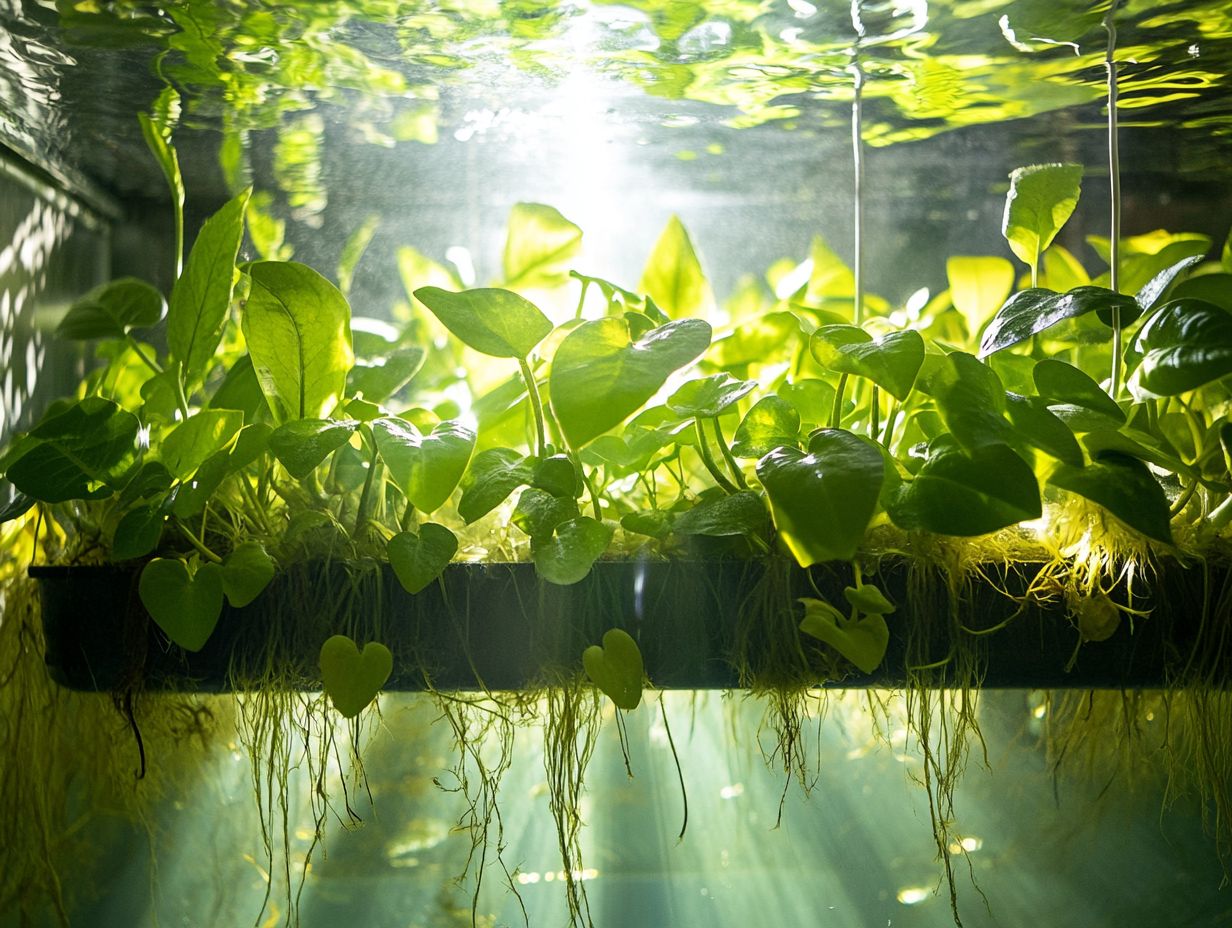
Establishing a passive hydroponic garden is a great project that’s surprisingly simple. With just a handful of essential materials and equipment, it becomes the perfect project for both novices and experienced gardeners.
Start by gathering net pots, a suitable growing medium like coconut coir, and a container to hold your nutrient solution think along the lines of a milk jar or a deep water culture tank.
This method is simple and allows you to cultivate a thriving garden of your favorite leafy greens, such as lettuce, spinach, and an array of herbs, all while keeping maintenance to a minimum.
Materials and Equipment Needed
To successfully create a passive hydroponic garden, you ll need a carefully curated selection of key materials and equipment that harmonize to support robust plant growth. These components are important in cultivating a thriving environment for your plants.
Net pots are important; they securely cradle your plants while allowing their roots to access vital moisture and nutrients. The nutrient reservoir is the system s lifeblood, offering a continuous supply of essential nutrients dissolved in water. Your choice of growing medium is equally important whether you opt for coconut coir, which excels in moisture retention, or Hydroton, celebrated for its aeration properties, both play a vital role in ensuring root stability and oxygen access.
Incorporating a pH meter along with a pH control kit will give you the power to monitor and adjust nutrient management meticulously, optimizing nutrient absorption and overall health, ensuring your plants not only survive but thrive.
Step-by-Step Guide
You can easily create a passive hydroponic garden that thrives! Start by selecting the plants you desire, then prepare your growing medium and net pots to cradle your seedlings. Next, mix your nutrient solution (a mix of water and nutrients that your plants need to grow) per the instructions, ensuring you hit that sweet spot with the pH level for optimal absorption.
Fill your nutrient reservoir, position the net pots in the container, and make sure the water level is just right to support the roots without risking root rot.
Once your setup is complete, keep an eye on the water level and top it off as needed maintaining the correct levels is essential for nutrient uptake. It’s also wise to check the nutrient solution weekly, replenishing it to keep the balance of essential minerals that will nurture healthy growth.
Place your system in a bright spot to help your plants grow strong, as adequate light exposure is crucial for photosynthesis (how plants use sunlight to make their food) and overall plant vitality. Pay attention to these details, and your passive hydroponic garden will thrive in no time!
Start today to enjoy fresh greens! Share your gardening journey and successes with us!
Plants That Thrive in Passive Hydroponic Systems
Many plants thrive in passive hydroponic systems. This method is versatile for growing a variety of vegetables and herbs.
Leafy greens, such as lettuce and spinach, excel in passive hydroponics. Their shorter growth cycles and lower nutrient demands make them ideal choices.
Tomatoes and peppers also thrive in this setting. You can grow a rich variety of produce without the challenges of traditional soil gardening.
Best Types of Plants to Grow
When exploring the best types of plants for passive hydroponic systems, leafy greens truly take the crown. Their rapid growth and minimal nutrient requirements make varieties like romaine lettuce and spinach perfect choices.
If you re feeling adventurous, you can also cultivate fruiting plants like tomatoes and peppers, provided you manage nutrients and pH levels effectively. pH levels refer to the acidity or alkalinity of your nutrient solution, which affects plant growth.
Herbs such as basil and mint shine in passive hydroponic setups. They thrive with the consistent moisture your system provides.
While leafy greens may thrive with fewer resources, more substantial fruiting plants require a tailored nutrient approach. By understanding the growth characteristics of each plant, you can enhance both your yields and the overall health of your passive hydroponics system.
Troubleshooting Common Issues
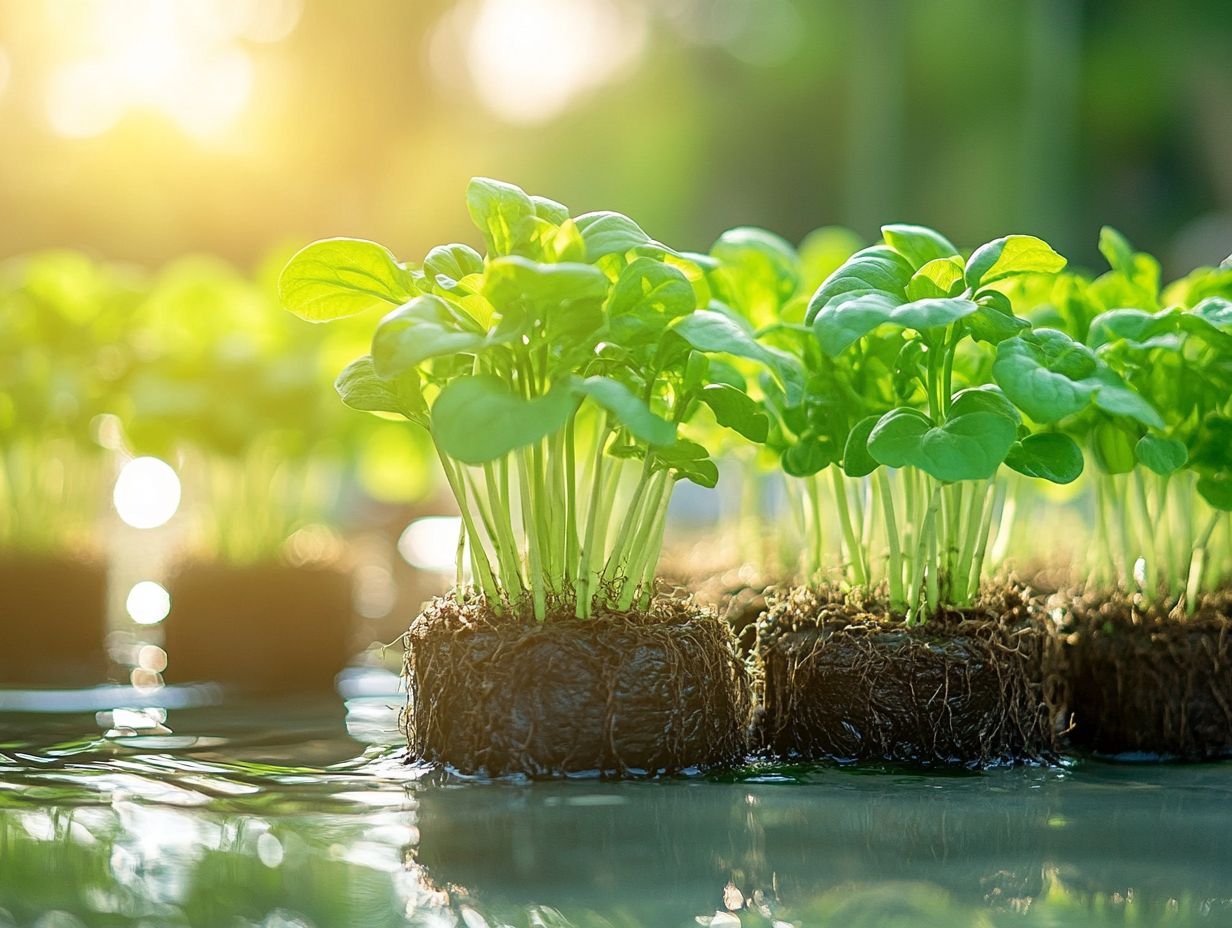
Troubleshooting issues in your passive hydroponic garden is essential. It helps your plants thrive and maximize yields.
Factors like nutrient imbalances, insufficient water levels, and incorrect pH management can create problems, including root rot and stunted growth.
Addressing these challenges swiftly can help you create a thriving hydroponic garden full of lush greens!
Identifying and Resolving Problems
Identifying and resolving issues is crucial for maintaining plant health. Common challenges, such as nutrient deficiencies or root rot, often show symptoms like yellowing leaves or sluggish growth.
These distress signals indicate underlying problems that need immediate attention. For example, if the pH level of your nutrient solution is off, your plants may struggle to absorb essential minerals, leading to stunted growth.
Analyzing your nutrient solution’s composition is vital. Insufficient levels of nitrogen, phosphorus, or potassium can manifest as specific deficiencies in your plants. Once you identify these issues, taking actionable steps like adjusting the pH, refreshing the nutrient solution, and ensuring proper aeration can restore plant vitality.
Maintaining and Harvesting from a Passive Hydroponic Garden
Maintaining and reaping the benefits of a passive hydroponic garden requires essential practices. These not only promote optimal plant health and yield but also streamline your gardening experience.
Regularly monitoring the nutrient solution’s composition, pH levels, and water levels is vital to sustain plant growth and prevent common problems.
When it’s time to harvest, using the right techniques to gather your leafy greens without causing damage will ensure continued growth and enable subsequent harvests throughout the season.
Proper Care and Harvesting Techniques
In your passive hydroponic garden, proper care and harvesting techniques are crucial for keeping your plants healthy and productive. Regularly check the nutrient-rich water for optimal pH levels and make adjustments as needed.
This can significantly enhance plant growth and yield. When it s time to harvest, consider cutting the leaves at the base instead of uprooting the entire plant.
You must maintain a nutrient balance that meets your plants’ specific needs. Different species may require varying levels of nitrogen, phosphorus, and potassium. Fine-tuning this balance helps prevent deficiencies that hinder growth or lead to subpar produce.
Keep an eye on pH levels! Even slight changes can impact nutrient uptake and cause stress to your plants. Utilizing methods like staggered planting can ensure continuous harvesting while fostering a healthy garden ecosystem, benefiting both your yield and your plants overall vitality.
Frequently Asked Questions
What is Passive Hydroponic Gardening?
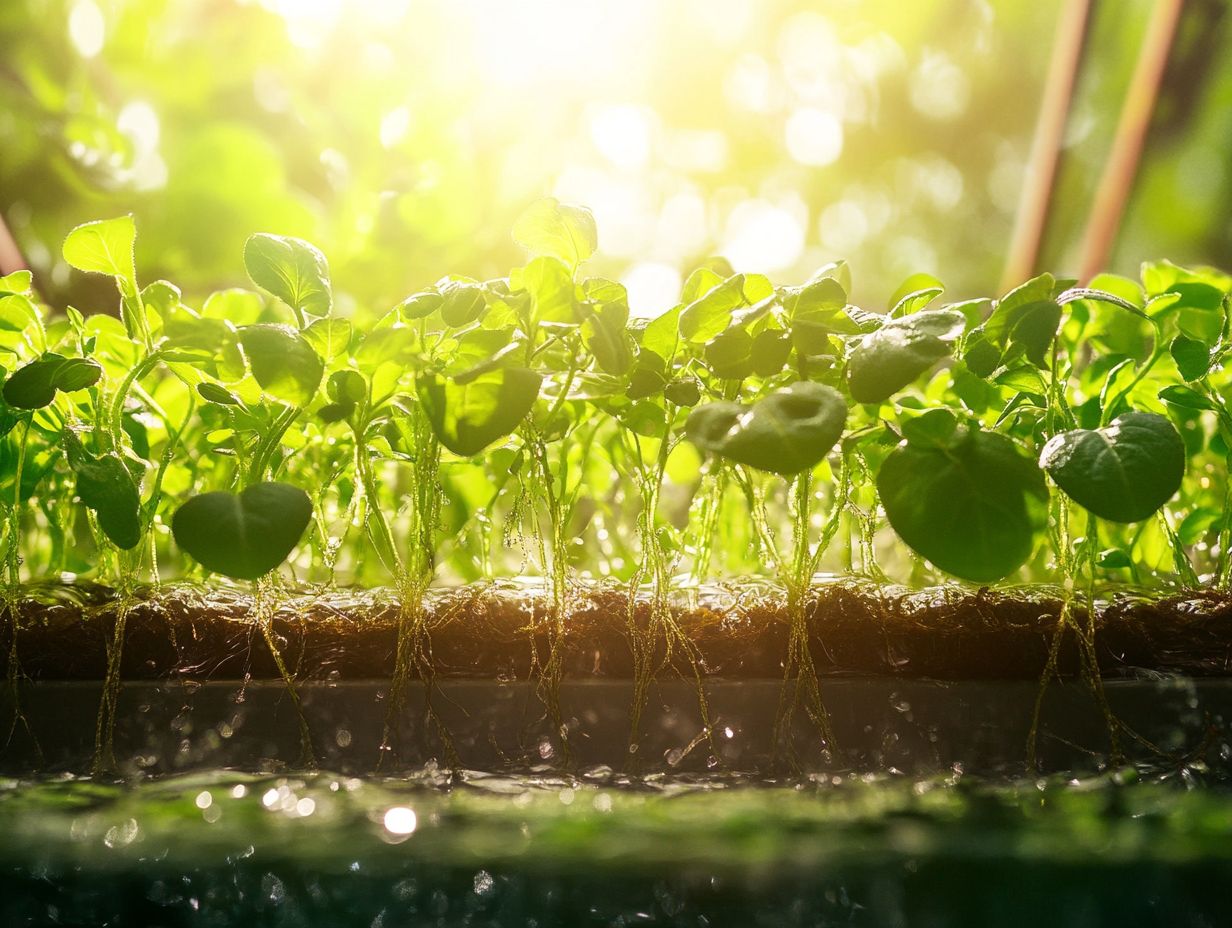
Passive hydroponic gardening is a method of growing plants without soil. Instead, it uses a water-based nutrient solution.
How does Passive Hydroponic Gardening work?
Passive hydroponic gardening works by using a wicking system to deliver nutrient-rich water to the plant’s roots. The plants are grown in a non-soil medium, such as coconut coir or perlite. The nutrient-rich water is slowly drawn up through the wick to provide the plants with the necessary nutrients.
What are the benefits of using Passive Hydroponic Gardening?
There are several benefits to using passive hydroponic gardening. It requires less space and uses less water while producing healthier plants with higher yields.
This method also eliminates the need for weeding, and there is no risk of soil-borne diseases.
Can I use any type of plant with Passive Hydroponic Gardening?
Yes, you can use a variety of plants with passive hydroponic gardening, including vegetables, herbs, and flowers.
However, some plants may be better suited for this method than others, so it’s best to do some research before choosing which plants to grow.
Do I need any special equipment for Passive Hydroponic Gardening?
While there are some specialized kits available for passive hydroponic gardening, you can also create your own setup. Use simple materials such as plastic containers, wicks, and non-soil growing medium.
This is a relatively low-cost and low-maintenance method of gardening.
Is Passive Hydroponic Gardening better than traditional gardening methods?
This ultimately depends on personal preference and the specific needs of your plants. Passive hydroponic gardening may be more efficient in terms of space and water usage.
However, traditional gardening methods have their own advantages as well. It’s worth trying out both methods to see which works best for you.
If you’re inspired, start your own passive hydroponic garden today!

